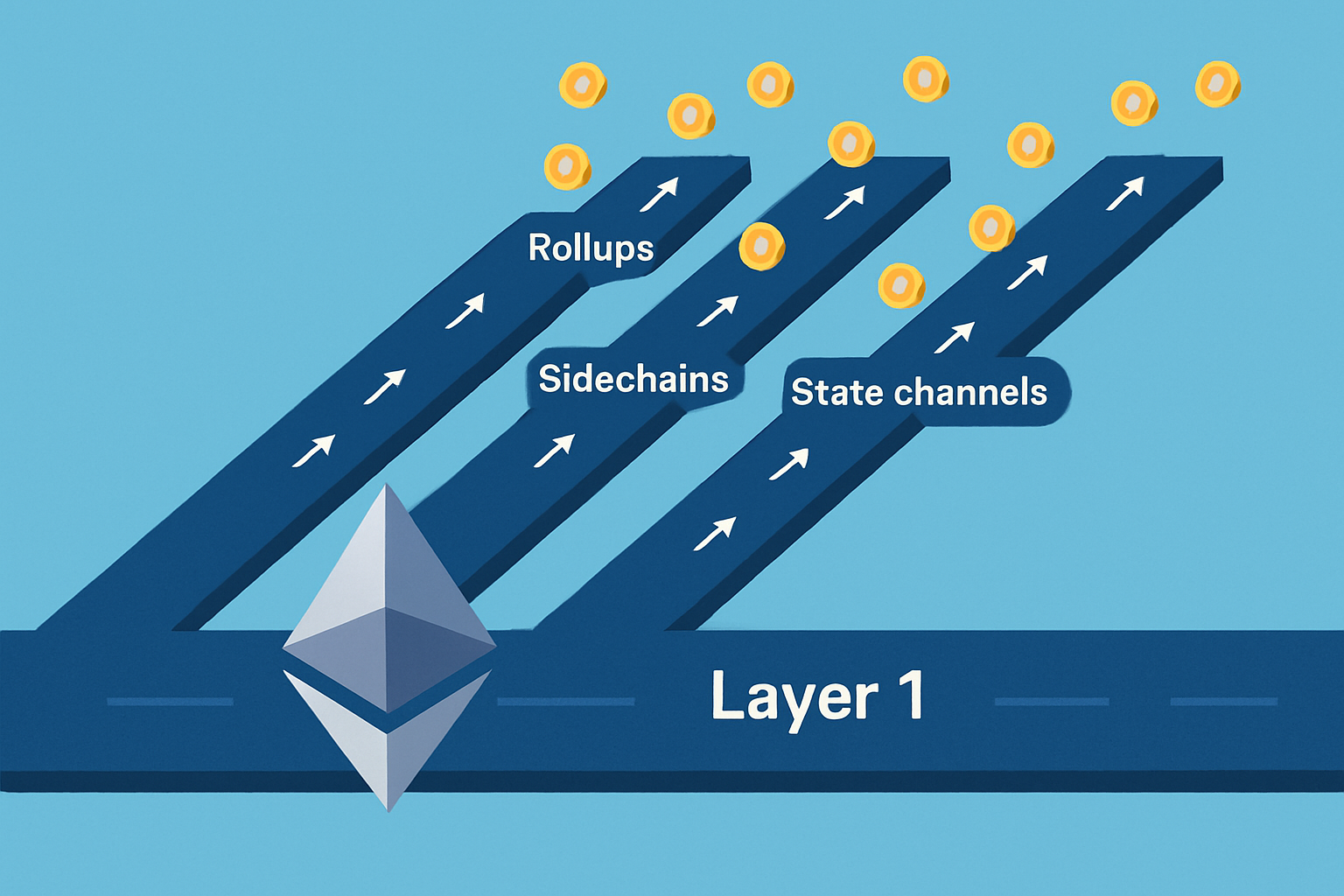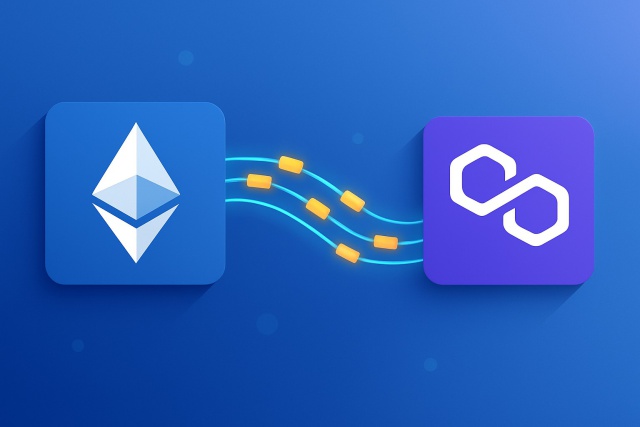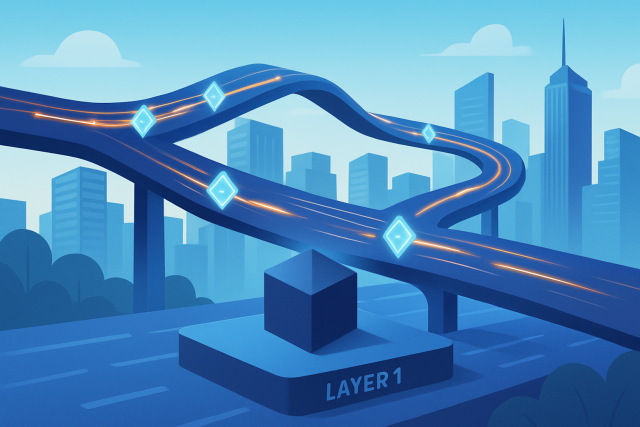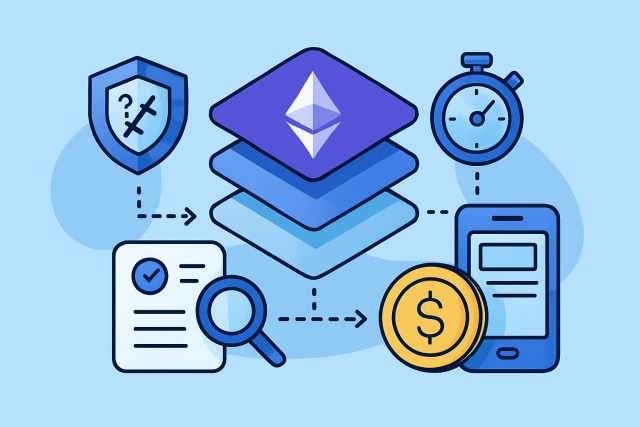How Layer 2 Works to Speed Up Transactions on Ethereum


Ethereum is definitely one of the heavyweight champs in the blockchain world, but it’s not without its quirks—like sometimes getting bogged down with slow transaction speeds and wallet-shrinking fees as the crowd grows. That’s where Layer 2 solutions step in, doing the heavy lifting off the main Ethereum chain.
Getting to Grips with Ethereum's Scalability Challenge (and Why It’s a Bigger Deal Than You Might Think)
Scalability tells us how smoothly a blockchain can handle more transactions without slowing down. At the moment, Ethereum's setup limits how many transactions it can handle simultaneously and this leads to frustrating delays and high fees we all grumble about.
Ethereum's blockchain processes transactions one at a time on its main chain. Every single action requires "gas"—a little fee paid to miners or validators—to get confirmed. When a bunch of users flood the network trying to push their transactions through all at once, things tend to slow down and congestion kicks in.
What is Layer 2? A Friendly Guide to the Basics
Layer 2 refers to a collection of protocols built on top of Ethereum’s main blockchain, often called Layer 1. These are designed to ramp up transaction speed and trim down fees—kind of like giving Ethereum a little caffeine boost. They handle some of the processing off-chain, yet still lean on Ethereum’s security like a trusty safety net.
- Work partly or fully off-chain to lighten the load on the main chain and give it breathing room
- Bundle transactions to crank up efficiency like rounding up friends for a group ride
- Slash transaction costs by trimming gas fees
- Speed up confirmation times to make the user experience smoother and less like waiting in line at the DMV
Layer 2 works a bit like those express lanes on a jam-packed highway. They take care of traffic on a separate track but still connect back to the main road, letting vehicles zip along faster without messing with the overall route or safety rules.
Understanding How Various Layer 2 Solutions Actually Work Their Magic
Layer 2 solutions each have their own quirky ways of scaling Ethereum. Some people move transactions completely off-chain, giving the main chain a bit of breathing room. Others lean on sidechains that run alongside Ethereum, sort of like its trusty sidekick. Then there are those clever ones using cryptographic proofs to bundle transactions more efficiently, squeezing out every bit of performance they can.
State Channels let participants handle transactions privately off the main chain, only sharing the final result when all's said and done.
Sidechains act as independent blockchains connected to Ethereum, doing their own transaction thing without bogging down the main chain.
Rollups cram a bunch of transactions off-chain but still post proofs back on-chain, covering both the popular Optimistic and the clever ZK-Rollups.
Plasma Chains create smaller 'child' chains anchored to Ethereum, giving transaction processing a much-needed boost in scale.
Understanding State Channels
Let's dive into state channels, which might sound a bit technical at first, but stick with me—they're actually pretty nifty once you get the hang of them. In a nutshell, state channels are a clever way to speed up blockchain transactions by moving interactions off the main chain. Think of it like taking the back roads to avoid rush hour traffic on the highway. This approach helps cut down on fees and latency, making everything run smoother and faster. What is really neat is that state channels keep everything secure, so you do not have to worry about stepping outside the safety of the blockchain's watchful eye.
State channels let two or more participants zip through multiple transactions off the Ethereum main chain without having to shout out every single one to the world. Think of it as setting up a private chat room where transactions zip by quickly and stay behind closed doors. When the channel finally closes, only the last agreed-upon state makes its way to the blockchain. This clever trick lightens the on-chain traffic and slashes fees, especially for repetitive stuff like gaming moves or tiny micropayments.
Understanding Sidechains
Dive into the world of sidechains, trusty side roads that bypass traffic on the main blockchain. They operate separately yet stay connected, boosting scalability and enabling new features without cluttering the original chain. Sidechains bring a fresh twist to the decentralized landscape.
Sidechains are separate blockchains linked to Ethereum through a two-way bridge that allows assets to zip back and forth between them. They take care of transactions on their own turf which generally results in quicker processing times and friendlier fees compared to Ethereum's busy main network. While they do a solid job easing the scaling pressure, sidechains rely on their own set of validators or consensus mechanisms so their security can vary.
Understanding Rollups
Let’s dive into the world of rollups—a neat little trick that is become a game changer in scaling blockchain tech. If you’ve ever felt like the blockchain world moves at a snail’s pace or burns through gas fees like there’s no tomorrow, rollups might just be the silver lining you have been looking for. They’re all about bundling transactions together, crunching the data off-chain, and then posting a summary back to the main chain—kind of like sending a postcard after a big family reunion instead of everyone mailing letters separately. Stick with me, and we will unravel why this matters more than you might think.
Rollups work their magic on Ethereum transactions by bundling a whole bunch of off-chain actions into a single batch, which then gets published on-chain as compressed data or a cryptographic proof. This nifty trick slashes the amount of on-chain data and gas required for each transaction, giving throughput a nice boost.
Optimistic Rollups work on the idea that transactions are good to go unless someone disputes them. They only kick off fraud proofs when there’s a real challenge. This method speeds things up nicely but you do have to wait a bit when disputes pop up. Meanwhile, ZK-Rollups take a different route by using zero-knowledge proofs to seal the deal on all bundled transactions from the start. This offers near-instant finality but puts a heavier load on computation.
Understanding Plasma Chains with a Gentle Dive Into the Tech
Plasma is a neat framework that spins up smaller 'child' blockchains, all tethered to Ethereum's main chain like diligent little satellites. These child chains handle transactions on their own turf and every so often send checkpoint states back to Ethereum, giving the main chain a much-needed breather. Plasma chains are no slouches when it comes to handling high transaction volumes, but be warned—they come with longer withdrawal times and a bit more of a tangled user experience.

How Layer 2 Solutions Give Ethereum Transactions a Much-Needed Boost
Layer 2 solutions step in to lighten the load by moving most transaction processing off of Ethereum’s busy Layer 1. They handle computations and communication off-chain or alongside it, freeing up room on the main Ethereum network.
- Transactions get included more quickly much to everyone’s relief
- Batch processing smartly groups multiple transactions together for on-chain settlement all at once which boosts efficiency and cuts down on the usual blockchain hustle
- Lower gas fees usually coax users into making transactions more often and in smaller chunks which feels like a win-win for everyone involved
- Achieving faster finality is more attainable than ever so user interactions feel smoother and quicker
Security on Layer 2 relies on cryptographic proofs and clever fraud detection plus the rock-solid finality that Ethereum’s main chain provides. Thanks to these safeguards, even when transactions are bundled off-chain any funny business can be challenged and straightened out.
Layer 2 solutions act like a speedy, parallel express lane for Ethereum’s traffic, cutting through the usual downtown rush hour chaos while still making sure every driver reaches their destination safe and sound, without breaking a sweat.
Real-World Examples and Applications of Layer 2 Technology—Where Theory Meets the Tangible
Layer 2 solutions are truly shaking up the way real-world Ethereum applications get things done. Decentralized finance (DeFi) platforms, NFT marketplaces and blockchain games often lean on Layer 2 to offer faster and cheaper experiences that run more smoothly.
- Optimism and Arbitrum bring their Optimistic Rollup magic mainly to DeFi protocols, giving trades and lending a serious boost in speed—making those often slow processes feel more like a sprint than a marathon
- Polygon’s sidechain tech supports many blockchain games and lets players take instant actions while keeping fees low—unexpected costs can be frustrating when you’re just trying to have fun
- Loopring leans on ZK-Rollups to tackle NFT minting, trading and payments. It slashes costs and cuts down delays in a way that’s as welcome as a cool breeze on a hot day
These Layer 2 platforms are a real game changer slashing pesky fees and speeding up transaction confirmations. They also let Ethereum networks handle thousands more users at once.
Challenges and Considerations When Working with Layer 2 Solutions
Layer 2 solutions come with their own set of trade-offs. Their security assumptions can be all over the place, and users might notice that things do not feel quite as seamless as native Ethereum. Shifting assets back and forth between Layer 2 and Layer 1 can be a bit of a waiting game, which can test your patience. On top of that, smart contract compatibility keeps throwing curveballs.
- Certain Layer 2 solutions rely on different trust assumptions than the Ethereum mainnet, so it’s not always a one-size-fits-all scenario
- Not every smart contract or decentralized app works across all Layer 2s, which can be frustrating if you’re used to things just working
- Liquidity tends to be scattered and this makes moving assets between layers a headache
- Onboarding new users often means jumping through extra hoops and ensuring their wallet supports the specific Layer 2, so patience is key
- Withdrawals from Layer 2 back to Layer 1 usually come with a waiting period. You’ll want to plan ahead and not expect instant magic
To make the most out of Layer 2 developers and users should aim to choose solutions that fit their security needs, zero in on onboarding tools that keep things simple and craft smart contracts designed to play nice with Layer 2.
What’s on the Horizon for Layer 2 and Ethereum Scalability
Ethereum’s transition to Ethereum 2.0 and the rollout of shard chains aim to boost scalability at the base layer. Meanwhile, Layer 2 solutions continue to hold their ground by offering scalable and low-cost environments without cutting corners on security.
New Layer 2 developments are really dialing up the focus on interoperability, making it a whole lot easier for users and applications to transfer assets and data seamlessly across different Layer 2 options. This multi-layer setup is designed to boost Ethereum's flexibility and usefulness by blending together the unique perks of various scaling methods.
Frequently Asked Questions
How do Layer 2 solutions reduce Ethereum transaction fees?
Layer 2 solutions ease the burden on Ethereum’s main chain by handling transactions off-chain or bundling many before sending a single batch to the main network. This method means fewer transactions compete for block space and helps lower gas costs. Take rollups for example. They pack hundreds of transactions into one package and share the gas fee among everyone involved, making it easier on your wallet.
Are Layer 2 solutions as secure as Ethereum’s main chain?
Layer 2 solutions rely on Ethereum’s rock-solid security for final confirmation but their trust setups can differ significantly. Rollups like Optimistic and ZK borrow Ethereum’s strong security by submitting proofs back to the main network while sidechains operate with their own consensus rules. It’s wise to look under the hood and understand the security model of any Layer 2 you’re considering.
Which Layer 2 solution is best for DeFi applications?
Optimistic Rollups such as Arbitrum and Optimism are popular picks in DeFi circles for their smooth EVM compatibility and wallet-friendly fees. Meanwhile, ZK-Rollups like zkSync offer faster finality but may require you to get comfortable with specialized tools. In the end, you’ll want to weigh your project’s needs for speed, cost and developer support before choosing the right fit.
How long does it take to withdraw assets from Layer 2 back to Ethereum?
Withdrawal times vary depending on which Layer 2 you’re using. Optimistic Rollups have a waiting period — a challenge phase for fraud proofs that can last one to seven days. ZK-Rollups and sidechains like Polygon usually process withdrawals within minutes or a few hours. The best approach is to check the latest documentation for your specific Layer 2 because rules can change and it pays to stay informed.
Can I use the same wallet for Layer 2 and Ethereum mainnet?
Most wallets you know and love including MetaMask support Layer 2 networks. However, you’ll often need to add the Layer 2 RPC details yourself. Moving assets between layers isn’t usually as simple as clicking a button. It often involves using a separate bridge contract or a dedicated dApp to complete the transfer.
Will Ethereum 2.0 make Layer 2 solutions obsolete?
Ethereum’s upcoming upgrades like sharding aim to improve the base layer’s scalability but they are more like teammates than replacements for Layer 2. Layer 2 solutions will continue to shine especially for high-speed and high-throughput apps like gaming and micropayments. They offer scaling options the main chain alone can’t cover as well.






